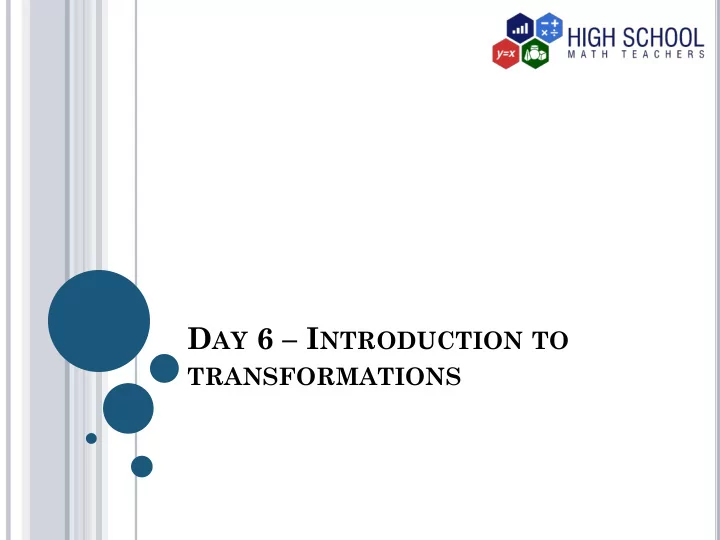

D AY 6 – I NTRODUCTION TO TRANSFORMATIONS
I NTRODUCTION Most objects can be put represented as a collection of many geometric objects. However, this geometric objects may not be in their original form; some may be twisted, stretched, turned a so on. This necessitates the a fact that before using these geometric objects, we understand these king of formations and deformations done. This is basically known as transformation. In this lessons, we are going to introduce the concept about most common transformations.
V OCABULARY Transformations This refers to a change in shape and position of an image from one form or location to another.
Transformations This refers to a change in shape and position of an image from one form or location to another. The most common transformations are translation, reflection, rotation and dilation. Apart from these, we have other such as stretch, shear. We refer to the initial figure as the pre-image and the final figure as an image. Translation This refers to a slip acting on an object. The slip can be in any direction. Because the pre-image is made to slip, its shape, orientation and size does not change.
pre-image Image Reflection This is a transformation where the object is flipped about a point or a line. The point or the line along which flipping occurs is called the mirror line . The image and the pre-image as a result of reflection are of the same size and shape and are at an equal distance from the mirror line.
pre-image Image Rotation This is a transformation here an object is turned from a fixed point. The fixed point where rotation occur is called the center of rotation and the angle through which the object is flipped is called the angle of rotation . The size and the shape of the image and the pre-image under does not change.
Image Object Center of rotation Dilation This refers to a reduction or increase in shape of an object by a factor. As a result, the size changes but the shape and orientation of the resultant object does not change.
This is done from a fixed point called center of enlargement (for increase in shape) or center of reduction. Image Object Center of enlargement
Transformation as a function Transformations is function that maps the elements in the domain to that of the range. The domain is composed of all points on the pre-image while the range is all points on the image. Since every point on the image is generated by a point in the pre-image, a transformation is termed as a one to one function. We would like to find out the kind of images under different transformation.
Translation The pre-image point (𝑦, 𝑧) will be mapped to an image point (𝑦 + 𝑏, 𝑧 + 𝑐) is it is translated by 𝑏 units in the horizontal direction and 𝑐 units in the vertical direction. Example1 If (2,4) is translated 4 units downwards, what would be its image.
Solution Downward movement is a movement in 𝑧 direction and in the negative direction, of 𝑧 , hence the image would be 2,4 − 4 = 2,0 . Reflection When an pre-image (𝑦, 𝑧) is reflected we get different images based on different mirror lines.
Mirror line image 𝑧 − 𝑏𝑦𝑗𝑡 (−𝑦, 𝑧) 𝑦 − 𝑏𝑦𝑗𝑡 (𝑦, −𝑧) Origin (−𝑦, −𝑧) 𝑧 = 𝑦 (𝑧, 𝑦) 𝑧 = −𝑦 (−𝑧, 𝑦) 𝑧 = 𝑐 (𝑦, 2𝑐 − 𝑧) 𝑦 = 𝑑 (2𝑑 − 𝑦, 𝑧)
Example 2 If (2,4) is reflected about 𝑧 = 𝑦 then about 𝑦 = 3 , what would be its image. Solution The point (2,4) implies 𝑦 = 2, 𝑧 = 4 . Reflection about 𝑧 = 𝑦 gives (𝑧, 𝑦) that is, 4,2 . After the first reflection, we have 𝑦 = 4 and 𝑧 = 2. Reflection about 𝑦 = 3 gives (2𝑑 − 𝑦, 𝑧) where 𝑑 = 3, 𝑦 = 4 and 𝑧 = 2 . The image would be 2 3 − 4,2 = (2,2)
Rotation When the pre-image (𝑦, 𝑧) is reflected we get different images based on different angle and center of rotation. Rotation is counterclockwise direction is taken to be negative. -ve rotation +ve rotation
Rotation Taking the origin as the center of rotation, the object 𝑦, 𝑧 , would be Angle or rotation Image −90° (𝑧, −𝑦) −180° (−𝑦, −𝑧) −270° (−𝑧, 𝑦) −360° (𝑦, 𝑧)
Example 3 If (2,4) is rotated through an angle of −270 about the origin. Solution The image of (𝑦, 𝑧) becomes (−𝑧, 𝑦) . Thus, the image would be (−4,2)
Dilation Dilation of a scale factor 𝑙, 𝑙 > 0 will map (𝑦, 𝑧) to 𝑙𝑦, 𝑙𝑧 . Among the above transformations, there are those that preserves angle (internal angles of the preimage) and distance (length of sides) and those that do not. For instance, Rotation, translation and reflection would preserve the angle and distance while dilation would not distance. For the case of other transformation; stretch preserves angle not distance while shear does not preserve both.
HOMEWORK Find the image of (−1, −3) under reflection about 𝑧 = −𝑦.
A NSWERS TO HOMEWORK (3, −1)
THE END
Recommend
More recommend